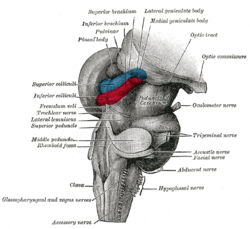جذع الدماغ
| المخ: جذع الدماغ Brain stem | ||
|---|---|---|
| الدماغ الخلفي والأوسط؛ منظر خلفي جانبي. | ||
| باللاتينية | truncus encephali | |
| گراي | subject #187 | |
| جزء من | المخ | |
| المكونات | Medulla, Pons, Midbrain | |
| NeuroNames | ancil-218 | |
| MeSH | Brain+Stem | |
| Dorlands/Elsevier | b_21/12195821 | |
جذع الدماغ إنگليزية: brainstem هو كتلة دماغية تصل بين المخ و الحبل الشوكي، و يتكون من الجسر والنخاع المستطيل والدماغ المتوسط. يتقل الاوامر من الدماغ إلى اعضاء الجسم و ينقل المعلومات الحسية من اعضاء الجسم إلى الدماغ وتوجد فيه مراكز التنفس وتنظيم الضغط ونظم القلب.ويتحكم في وظائف الجسم الحرجة وغير الإرادية كمايتحكم في الوعي واليقظه والنوم والاحساس بالألم واصابة هذا الجزء من الجسم غالبا ماتؤدي للوفاة .وتنطلق منه اللأعصاب الدماغية العليا التي تتحكم في حواس الوجه كالعين والاذن (السمع والبصر) والذوق والشم والبلع واللعاب وعضلات الوجه المعبرة .
تشريح
 مقالة مفصلة: دماغ متوسط
مقالة مفصلة: دماغ متوسط
| الجهازالعصبي المركزي | دماغ | دماغ أمامي Prosencephalon أو forebrain | مخ Telencephalon أو Cerebrum |
دماغ شمي Rhinencephalon ، أميگدالا = لوزة عصبية Amygdala ، حصين Hippocampus ، قشرة جديدة Neocortex ، بطينات جانبية Lateral ventricles |
|
| دماغ بيني Diencephalon |
مهيد Epithalamus ، مهاد Thalamus ، الوطاء أو تحت المهاد Hypothalamus, مهاد تحتاني Subthalamus ، غدة نخامية Pituitary gland ، غدة صنوبرية Pineal gland ، البطين الثالث Third ventricle |
||||
| جذع الدماغ Brain stem | دماغ متوسط Mesencephalon |
سقف (تشريح عصبي) Tectum ، سويقة مخية Cerebral peduncle ، برتيكتوم Pretectum ، مسال دماغي Mesencephalic duct أو cerebral aqueduct |
|||
| دماغ خلفي أو دماغ مؤخري Rhombencephalon | دماغ تالي Metencephalon | ||||
| دماغ بصلي Myelencephalon | البصلة Medulla oblongata | ||||
| النخاع الشوكي Spinal cord | |||||
الفيزيولوجيا
There are three main functions of the brain stem:
1. The first is its role in conduct functions. That is, all information related from the body to the cerebrum and cerebellum and vice versa, must traverse the brain stem. The ascending pathways coming from the body to the brain are the sensory pathways, and include the spinothalamic tract for pain and temperature sensation and the dorsal column, fasciculus gracilis, and cuneatus for touch, proprioception, and pressure sensation (both of the body). (The facial sensations have similar pathways, and will travel in the spinothalamic tract and the medial lemniscus also). Descending tracts are upper motor neurons destined to synapse on lower motor neurons in the ventral horn and intermediate horn of the spinal cord. In addition, there are upper motor neurons that originate in the brain stem's vestibular, red, tactile, and reticular nuclei, which also descend and synapse in the spinal cord.
2. The cranial nerves 3-12 emerge from the brain stem.
3. The brain stem has integrative functions (it is involved in cardiovascular system control, respiratory control, pain sensitivity control, alertness, and consciousness). Thus, brain stem damage is a very serious and often life-threatening problem.
العلامات الطبيعية لمرض جذع الدماغ
Diseases of the brain stem can result to abnormalities in the function of cranial nerves which may lead to visual disturbances, pupil abnormalities, changes in sensation, muscle weakness, hearing problems, vertigo, swallowing and speech difficulty, voice change, and co-ordination problems. Localizing neurological lesions in the brain stem may be very precise, although it relies on a clear understanding on the functions of brain stem anatomical structures and how to test them.
انظر أيضاً
المصادر
- http://www.neuroskills.com/tbi/bbstem.shtml
- http://www.cancerhelp.org.uk/help/default.asp?page=5019
- http://www.meddean.luc.edu/lumen/Meded/Neuro/frames/nlBSsL/nl40fr.htm
- http://biology.about.com/library/organs/brain/blbrainstem.htm
- http://www.waiting.com/brainanatomy.html
- http://www.martindalecenter.com/MedicalAnatomy_3_SAD.html

